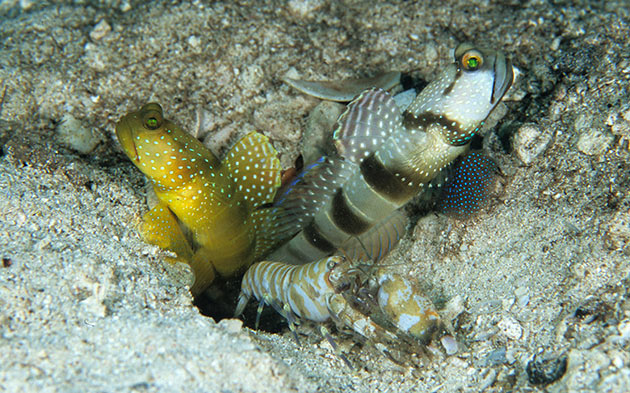
The marine aquarium hobby can open up an incredible world to the amateur naturalist. Not only does the saltwater hobbyist have an opportunity to keep a wide array of interesting invertebrates and fishes, they can also observe some of the fascinating symbiotic relationships that occur on coral reefs. For example, we are all familiar with the Sea Anemone-Anemonefish association. This unusual partnership has been responsible for enticing many pet store browsers into setting-up a marine aquarium. But I think there is an even more fascinating fish-invertebrate association. This symbiotic relationship involves a number of Goby genera and certain Snapping Shrimps (family Alpheidae). Let’s take a closer look at these fascinating burrow fellows starting with the fish partners.
Gobies
Gobies are becoming more and more popular in the home aquarium. They are also one of the largest families of fishes represented on coral reefs. It is currently estimated that there are over 1,875 described Goby species with many more waiting to be formally named. Gobies are ideally suited for the home aquarium. One reason is because of their diminutive proportions. This family includes the smallest known fish (the Dwarf Goby, Trimmatom nanus), which attains a maximum length of less than 0.5 inches. The largest of the Gobies get about 20 inches in length; although, the majority do not exceed 5 inches.
Over half of the known Goby species live on or in habitats adjacent to coral reefs, like sand flats, sand slopes, sea grass beds or mangrove swamps. One drawback in living in open sand or mud bottoms is that they have fewer places to hide when compared to the labyrinth-like structure created by a coral reef. As a result of the lack of available hiding places, Gobies that live in these habitats have to rely on different strategies to avoid being eaten. Some are attired in cryptic colors so that they blend in with their surroundings. Others dig holes under scattered rubble or debris. But there is also a group of Gobies that form partnerships and refuge with unrelated marine organisms (a phenomenon known as interphyletic symbiosis).

Cryptocentrus leptocephalus |
Snapping Shrimps
Shrimps also reach their apex of diversity on coral reefs. One group of Shrimps, most of whose members are part of the reef’s cryptofauna (“hidden fauna”), are the Snapping or Pistol Shrimps (Family Alpheidae). These crustaceans get their name from their greatly enlarged claws. When these oversized appendages are snapped shut, it creates an audible popping sound. They use their claws to stun their prey, to ward off predators, and to warn potential rivals of their territory boundaries. These Shrimps are occasionally available to reef keepers, who use them to help keep their aquarium substrate stirred. However, most of the Snapping Shrimp that enter aquariums do so incidentally in live rock.
While many Snapping Shrimps live in hard substrate, there are some that construct burrows in the sand or mud. The size and shape of these burrows vary, depending on the species and size of the shrimp, as well as the type of substrate in which the burrow is constructed. For example, the burrows of four Snapping Shrimp species from the Red Sea are usually 32 to 47 inches in length (they can exceed 87 inches) and are situated 12 to 22 inches under the sand surface. The entrances to the burrows are typically from 1 to 2 inches in diameter, with deeper, longer burrows having larger entries. The burrows may have from one to six openings, although most have three or less. They are usually dug under hard objects, like large shells, chunks of coral rubble, or coral mounds.

Amblyeleotris yanoi |
After the Shrimp build their burrows, they have to maintain them. Most of the repair and maintenance occurs in the mornings. The openings cave in and erode at night when the Shrimp suspends its maintenance activities. This effectively seals the burrow inhabitants in for the night. In the morning, the Shrimp clears new openings and completely closes old ones. They push loose sediment away from the burrow and grasp pieces of rubble and shell with their claws and carefully place them around the burrow entrance. In the afternoon, the Shrimp turns its attention from burrow to metabolic maintenance, spending more of its time feeding on detritus among the bottom sediments.
While life may appear rosy for these burrow-constructing Snapping Shrimp, they have one big predicament. Because these Shrimps have poor eye-sight, they are very vulnerable to being “picked off” by predators as they take care of their burrows or as they forage around the burrow openings.

Cryptocentrus cinctus |
Shrimp Meet Goby – Goby Meet Shrimp
So how do the Shrimp overcome their apparent visual handicap? Enter the Shrimpgobies. As we discussed above in our general Goby survey, there are a number of Gobies that live in sand or mud habitats that are looking for a way to avoid predators. It turns out there are some Gobies that avoid predators by teaming up with the Snapping Shrimp. The members of the following genera are known to live within the burrows of these poor-sighted crustaceans: Amblyeleotris, Cryptocentrus, Cryptocentoides, Ctenogobiops, Flabellogobius, Gobionellus, Lotilia, Mahidolia, Myersina, Nes, Psilogobius, Smilogobius, Stonogobiops and Vanderhorstia. These fishes are referred to collectively as Shrimp, Partner, Prawn, or Watchman Gobies.
The Shrimpgoby-Snapping Shrimp relationship is a mutualistic one – that is, it’s an association where both members benefit. The primary benefit to the Goby is obvious. The Shrimp’s burrow provides a sanctuary for the otherwise vulnerable fish. But the Goby benefits in more ways as well. When the Snapping Shrimp engages in maintenance activities, the Goby gains access to buried prey organisms. I have seen these Gobies ingest worms exposed by the Shrimp’s bull-dozing activities. I have also noticed that the Gobies take mouthfuls of newly turned sand and sift it through the gills or sort it in their mouth and then spit out the inedible materials. This newly exposed sand may have more infaunal prey items to feed on than the “old” sand.
Underwater observations have also shown that the Gobies are occasionally "cleaned" by their crustacean landlords. In captivity, Snapping Shrimp have been observed using the second pair of chelae (claws) to pick at the Goby's head, dorsal fin and tail. Snapping Shrimps have been observed picking at Gobies in the wild as well. Finally, the Shrimp’s burrow serves as a repository for the Gobies spawn. During the breeding season the female Goby deposits her fish eggs in the burrow.

Cryptocentrus pavoninoides |
Shrimp Benefits
So how does the Goby benefit its industrious partner? The Shrimpgobies act as "seeing-eye" fish for their poor-sighted crustacean partners. As the Shrimp keeps house or feeds just outside of the burrow, the Goby will position itself near the burrow’s entrance and “stand guard.” In some cases, when the Goby is reluctant to leave the burrow, the shrimp will push the Goby out with its claws or, on rare occasions, it will even pinch the Goby. The tidy little crustacean moves freely in and out of its refuge, but when it leaves the burrow it keeps in contact with the vigilant Goby. It does this by placing one of its antennae on the fish. (This antennal contact is the critical line of communication between the two animals.)
When a predatory fish approaches, the Goby will rapidly flick its tail, warning the Shrimp of impending danger. If the Goby flicks its tail once, the Shrimp may not immediately respond, but if the Goby executes a series of flicks the Shrimp will quickly back into the burrow. If the predator comes within a critical distance, the Goby will also dart (headfirst) into its hiding place. Gobies are able to discriminate between fishes that are potentially dangerous and those that are not. This is advantageous, as it would be a waste of time and energy if the Goby warned the Shrimp or retreated every time a fish moved near the burrow. The Goby is most likely to communicate (warn) the Shrimp if an intruding species is large. Smaller fish are less likely to elicit a warning from the Goby. Fishes that eat small fishes and shrimps also will elicit a warning signal.
How do the Goby and Shrimp find each other in the first place? Apparently, Gobies visually locate a Shrimp associate, while the crustaceans use chemical cues to recognize their fish partners. It’s interesting to note that certain Gobies are quite particular about the company they keep. They only occur with one or few shrimp species. For example, in the Indian Ocean, Wheeler’s Shrimpgoby (Amblyeleotris wheeleri) is only found with the Snapping Shrimp (Alpheus ochrostriatus). But, there are other Gobies that are less selective. For example, over certain parts of its range, Steinitz's Shrimpgoby (Amblyeleotris steinitzi) can be found residing with several different Alpheus spp.
Part 1:
Shrimpgoby and Snapping Shrimp Symbiosis |
| |
Part 2:
Captive Care of Shrimpgoby and Snapping Shrimp |

Scott Michael
Scott W. Michael is an internationally-recognized writer, underwater photographer, and marine biology researcher specializing in reef fishes, and was the Banquet Speaker at our 2007 and 2008 Coral Conference and Frag Swap. He is a regular contributor to Aquarium Fish Magazine, Freshwater and Marine Aquarium Magazine, SeaScope, and is the author of Reef Fishes Vol 1, Vol 2, and Vol 3, Vol 4, and Vol 5., A Pocket Expert Guide Marine Fishes, A Pocket Expert Guide to Reef Aquarium Fishes, 101 Best Saltwater Fishes: How to Choose and Keep Hardy, Brilliant, Fascinating Species That Will Thrive in Your Home Aquarium, Reef Sharks & Rays of the World, and Aquarium Sharks & Rays. Having studied marine biology at the University of Nebraska, Scott has served as a scientific consultant for National Geographic Explorer, the Discovery Channel, and French educational television.
|